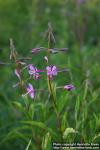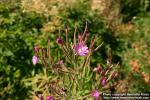Epilobium.—Willow Herb.

 The leaves and root of Epilobium angustifolium, Linné, and Epilobium palustre, Linné.
The leaves and root of Epilobium angustifolium, Linné, and Epilobium palustre, Linné.
Nat. Ord.—Onagraceae.
COMMON NAMES: I. Epilobium angustifolium—Willow herb, Great willow herb, Rose-bay, Wickup. II. Epilobium palustre—Marsh epilobium, Wickop, Swamp willow herb.
Botanical Source.—Epilobium angustifolium. This plant, sometimes known as Rose-bay, is the Epilobium spicatum of Lamarck; it is a perennial, indigenous plant, with a simple, erect stem from 4 to 6 feet in height. The leaves are scattered, lanceolate, sessile, smooth, subentire, with a marginal pellucid vein, from 2 to 5 inches in length, and one-fourth as wide. The flowers are large, numerous, very showy, pink-purple, and in a long terminal spike or raceme. The corolla has 4 deep, lilac-purple petals, clawed, and widely spreading. The calyx-tube is not prolonged beyond the ovary; the limb is 4-cleft, 4-parted, and deciduous. Stamens 8, and as well as the style, turned to one side. The stigma has 4 linear, long, revolute lobes. The ovary and capsule are long, linear, 4-cornered, 4-celled, and 4-valved; and the seeds numerous with a tuft of long hairs (W.—G.). Epilobium palustre has a terete, branching, somewhat hirsute stem, growing from 1 to 2 feet in height, sessile, lanceolate, or linear, entire or subdenticulate, smooth leaves, attenuate at base, rather acute, alternate; lower ones opposite, and from 1 to 3 inches long, and one-third as wide. The flowers are small, numerous, axillary, rose-colored, or purplish, and in the narrow-leaved variety (var. albidum), white. The petals are small, obcordate, twice longer than the calyx; style included; stigma clavate; capsules 1 or 2 inches long, not over ⅛ of an inch in diameter, borne on short pedicels, and pubescent.
History and Chemical Composition.—Epilobium angustifolium, when in bloom is a conspicuous feature of our landscape, from July to September. It grows plentifully from Pennsylvania northward, and to some extent in the mountainous districts of North Carolina, and from thence westward and northward. Like fireweed (Erechtites hieracifolia), it may be found growing in one place one year, and the next year may disappear therefrom, and reappear in a new situation several miles distant. In some localities, however, it is almost constant, coming year after year in the same spot. This plant is known by various names, the best known of which are willow herb, wickup, and rose-bay. In contradistinction to other species known likewise as wickup and willow herb, it is called great willow herb. Willow herb is a perennial, growing along waysides, railroads, along the fences of pasture lands, as well as in new ground recently cleared by burning. Mr. C. J. Biddle found the root of Epilobium angustifolium to contain mucilage, tannin, starch, sugar, resin, and a crystalline calcium salt (Amer. Jour. Pharm., 1877). Several species of epilobium are indigenous, Epilobium palustre or swamp epilobium being valued as possessing similar medicinal virtues to the plant in question. The roots of epilobium possess some activity, but the leaves are preferred. They yield their virtues to water or alcohol.
Epilobium palustre, or Swamp willow herb, grows in swamps and marshes from Pennsylvania to Arctic America, and westward to Oregon.
Action, Medical Uses, and Dosage.—Epilobium has never attained a place in the front rank as a medicine. This is often the case with drugs that have not decided poisonous properties, or with such drugs as have not yielded to the chemist an active principle. That it has not attained prominence as a remedy is not the fault of the plant, for in certain cases of summer bowel troubles it is without an equal. The infusion is probably the best form of administration, though alcoholic preparations are not without remedial activity. Specific epilobium is a reliable preparation. The infusion is not unpleasant, its taste being somewhat like that of tea. Epilobium is tonic, astringent, demulcent and emollient. The uses given for it are many, but we would particularly allude to its value in summer bowel complaints. It has a deserved reputation in chronic diarrhoea, and it has been known to give better service than other remedies in diarrhoeas following, or dependent in the first place on "camp or army diarrhoea." The infusion should be freely used. Several cases of diarrhoea of a watery character, due to change of drinking water, have been promptly checked by the infusion or the tincture. Certain forms of cholera infantum, especially with greenish discharges of undigested aliment, have been controlled by this agent in domestic practice, where the ordinary remedies prescribed by the physician failed to have any beneficial effect. It is prominent as a remedy for muco-enteritis. Administered in very small doses it has proven effective in a large number of cases of typhoid dysentery. With Prof. Scudder, infusion of epilobium was a favorite remedy to correct and restrain the diarrhoea of typhoid or enteric fever. In this particular condition others attest its efficacy. It is a good remedy in intestinal irritation, as a wrong of intestinal digestion. It is indicated here by the pinched features, emaciation, and the slick, contracted tongue, the papillae being somewhat effaced. It is further indicated in bowel troubles by impairment of digestion with uneasy sensations in the abdomen, amounting to pain, accompanied by diarrhoea and having the above symptoms of bowel irritation.
An infusion of the leaves will be found beneficial in leucorrhoea, menorrhagia, and uterine hemorrhage; and forms an excellent local application for ophthalmia, ulcerations of the mouth and throat, and leucorrhoea. The leaves in poultice are a valuable remedy for foul and indolent ulcers. Dose of the infusion, sweetened if desired, from 2 to 4 fluid ounces, 5 or 6 times a day, or smaller doses may be repeated every 10, 20, 30 or 60 minutes as required.
Epilobium palustre, marsh epilobium, wickop, or swamp willow herb, is said to be a valuable article in colic and in irritable conditions of the intestines; in severe dysentery, camp diarrhoea, formerly known as "Mexican diarrhoea,'' and cramp of the stomach. In fact it acts similarly to willow herb. It has proved quite successful in some very severe cases of colic and dysentery, even after the failure of other agents. Prof. J. M. Scudder extols this plant very highly in the above diseases, and also in ulceration of the bowels attending typhoid fever, as it quiets irritation, gradually checks diarrhoea, and relieves tenderness and tympanitis. He prescribes a tablespoonful every hour of an infusion made by infusing an ounce of the herb in ½ pint of boiling water. The dose of specific epilobium ranges from 10 to 60 drops. The infusion may be freely used.
Specific Indications and Uses.—Prof. Scudder gives the following specific indications: "Diarrhoea, with colicky pain; feculent discharges with tenesmus; diarrhoea, with contracted abdomen; chronic diarrhoea, with harsh, dirty, contracted skin." Diarrhoea of typhoid fever; typhoid dysentery.
 Related Species.—Epilobium hirsutum, Linné; Great hairy willow herb, Fiddle-grass, Codlins-and-cream. Adventive from Europe, and found in waste places in eastern New England, Ontario, central New York, and in the ballast near seaports (Britton and Brown). Dr. Oliver (see Amer. Hom., 1897, p. 442) reports the case of a three-year-old boy, poisoned by eating Epilobium hirsutum. The symptoms were profound coma and recurring epileptiform convulsions.
Related Species.—Epilobium hirsutum, Linné; Great hairy willow herb, Fiddle-grass, Codlins-and-cream. Adventive from Europe, and found in waste places in eastern New England, Ontario, central New York, and in the ballast near seaports (Britton and Brown). Dr. Oliver (see Amer. Hom., 1897, p. 442) reports the case of a three-year-old boy, poisoned by eating Epilobium hirsutum. The symptoms were profound coma and recurring epileptiform convulsions.

